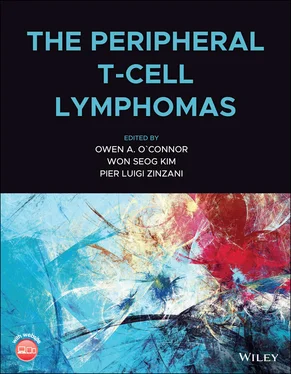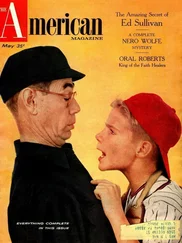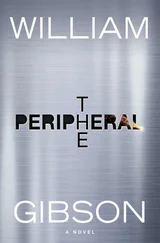In addition to TP53 inactivation, CDKN2A deletions have also been reported in several PTCLs. CDKN2A , located on chromosome 9, encodes for two transcripts, p16INK4a and p14ARF. p16INK4a is involved in cell‐cycle regulation, via inhibition of cdk4 and cdk6, resulting in activation of retinoblastoma proteins, while p14arf controls MDM2 activity via sequestration. MDM2 is an E3 ubiquitin ligase that recognizes the N‐terminal transactivation domain of the p53 tumor suppressor, resulting in its degradation. Thus, CDKN2A deletion can result in increased MDM2 function and excessive p53 degradation. CDKN2A deletions are frequent in CTCL, especially in aggressive forms, as they are observed in more than 50% of patients in transformed mycosis fungoides or Sézary syndrome, while they are rare in CD30+ cutaneous ALCL [55]. In ATLL, CDKN2A deletions are reported in 50% of patients with the acute form, but in only 20% of patients with chronic clinical variants of the disease [56]. Deletion of CDKN2A , found in up to 50% of patients with PTCL‐NOS with enrichment in GATA3/Th2 signature, is reported to correlate with shorter survival and poor prognosis [6, 53].
TP63 is rearranged in a small proportion (< 10%) of ALCL, where it correlates with intense P63 expression [2]. Although TP63 is a TP53 homolog, its role as a tumor suppressor gene is unclear. However, cases with TP63 rearrangement correlate with an aggressive clinical behavior [2, 57].
The immune system perpetually eradicates the formation and progression of incipient neoplasia, and evading the immune control is one of the hallmarks of cancer. Two main mechanisms of immune escape may be employed. On the one hand, neoplastic cells can overexpress surface ligands such as PDL1, PDL2, which, after receptor engagement, result in anergy of tumor infiltrating lymphocytes. On the other hand, T and NK neoplastic cells may avoid immune recognition through the loss of class I CMH and or beta2 microglobulin alterations and CD58 anomalies. CD58 is a member of immunoglobulins superfamily which acts as a ligand for CD2 that allows activation of T and NK cells. Those alterations are found in several lymphomas, especially in diffuse large B‐cell lymphomas [58]. It is noteworthy that alterations in CMH and beta 2 microglobulin or CD58, impairing the recognition by T or NK cells have been described in ATLL [46] and PTCL‐NOS [53].
The efficacy of immunotherapy such anti‐PD1 or anti‐CTLA4 antibodies in several cancers also reinforces the importance of immune escape of neoplastic cells. However, targeting the immune system in PTCL is far more complex, as the neoplastic targets are T cells themselves, in which the TCR, co‐stimulation system and cytokines receptors may be functional. As mentioned above, structural variants in the 3′ UTR part of PDL1 have been reported in ATLL [9], ENKTL or other EBV‐related T‐ or NK‐cell lymphomas [10]. The 3′ UTR is a region allowing posttranscriptional regulation of mRNA level through action of microRNA or regulating proteins. These structural variants result in PDL1 overexpression, contributing to immune escape. It is noteworthy that relapsed/refractory ENKTL show a high response rate to anti‐PD1 therapy [59].
In CTCL, a gene fusion between CD28 and CTLA4 results in a chimeric receptor with the extracellular domain of CTLA4 and the intracellular domain of CD28 [60]. This CTLA4–CD28 fusion converts the negative inhibitory effect normally exerted by CTLA4 ligands expressed by reactive cells surrounding neoplastic T cells, into an activating signal driven by the intracellular CD28‐derived segment of the chimeric receptor. In this setting, deregulated signaling resulting from the structural change of the receptor, is not autonomous and exemplifies the cooperation between microenvironment and intrinsic changes in the neoplastic cells.
Role of the Microenvironment in Peripheral T‐cell Lymphoma
In PTCLs, the microenvironment, reactive cells and stroma, is quantitatively and qualitatively variable. However, its characterization remains largely unexplored and the functional interactions between the microenvironment and neoplastic components poorly understood.
The Model of Angio‐immunoblastic T‐cell Lymphoma and T Follicular Helper‐derived Peripheral T‐cell Lymphoma
AITL exemplifies a disease with a major microenvironment component. Its designation itself reflects the typically prominent vascularization of high endothelial venules and the presence of reactive immunoblasts. In fact, the neoplastic cells are often outnumbered by a polymorphous infiltrate comprising not only large B‐cell blasts, but also plasma cells, follicular dendritic cells (FDCs), reactive CD4 and CD8 T lymphocytes, eosinophils, macrophages, and mast cells. At the molecular level, up to 90% of the AITL gene expression signature can be attributed to the microenvironment, with overexpression of B‐cell (including immunoglobulins) and FDC‐related genes, chemokines and chemokine receptors (CCL19, CCL20, CCL22, CCL24, IL4) and genes related to extracellular matrix and vascular biology (such as vascular endothelial growth factor [VEGF], thrombomodulin, angiopoietin 2) [61].
A complex network of interactions between the lymphoma cells and other cell components likely takes place, and a dependency on the microenvironment is also supported by the fact that a self‐sustaining lymphoma cell line could not be established so far.
Crosstalk Between Neoplastic T Follicular Helper Cells and Their Microenvironment in Angioimmunoblastic T‐cell Lymphoma
The cellular derivation of AITL from Tfh cells provides a rational model to explain the formation of the characteristic AITL microenvironment. Tfh cells represent a distinct functional subset of effector T‐helper (Th) cells, which normally reside in germinal centers where critical interactions with germinal center B cells promote B‐cell survival, immunoglobulin class‐switch recombination and somatic hypermutation, ultimately yielding high‐affinity plasma cells and memory B cells [62].
On tissue sections, a close contact is observed between neoplastic AITL cells, FDCs and B cells, the three important key players in the disease ( Figure 2.2). Large B immunoblasts, often infected by EBV, interact with neoplastic Tfh cells, as exemplified by the rosettes of neoplastic Tfh cells often seen around B‐cell blasts. These interactions are mediated by ligand‐receptor pairs expressed on the membrane (such as ICOS‐ICOS‐L and CD40‐CD40L) and cytokines/chemokines secretion. CXCL13 secreted by neoplastic Tfh cells is likely a major mediator that can promote B‐cell expansion and plasmacytic differentiation. In addition, CXCL13‐producing FDCs could also interact with neoplastic Tfh cells which express CXCR5, resulting in localization of these cells to the germinal center [63]. Lymphotoxin beta, also expressed in AITL tumor cells [64], might be involved in inducing FDC proliferation. Interleukin (IL) 6 produced by Tfh cells and myeloid cells can promote plasma cell proliferation [65]. IL21, the major cytokine secreted by Tfh cells, exhibits an autocrine effect on the IL21‐positive Tfh, and also exerts positive effects on B cells. The role of VEGF and its receptor, both expressed by neoplastic and endothelial cells in AITL, has been proposed in promoting vascularization observed in the disease. A number of chemokines, like CCL17/TARC, or cytokines such as IL4, IL5, and IL13 demonstrated in CD3+ T cells isolated from AITL lymph nodes, are potential mediators of eosinophilic infiltrate in tissue biopsies and/or eosinophilia [66]. AITL also comprises a variable number of macrophages, with various phenotypes and functions [67].
Читать дальше












